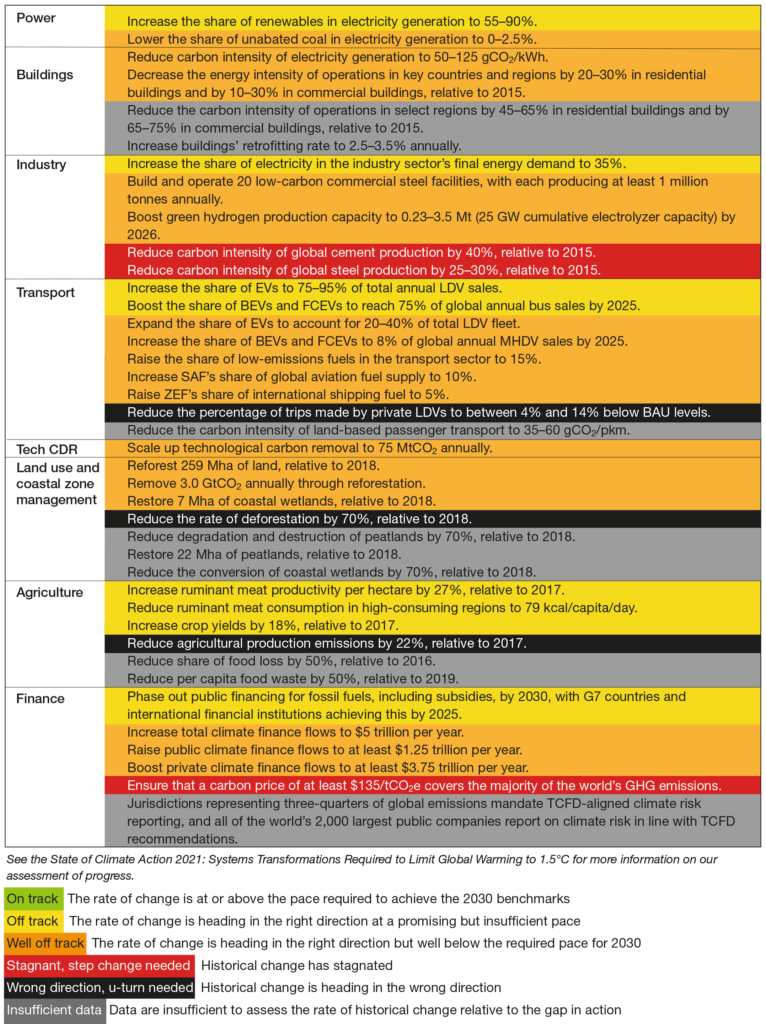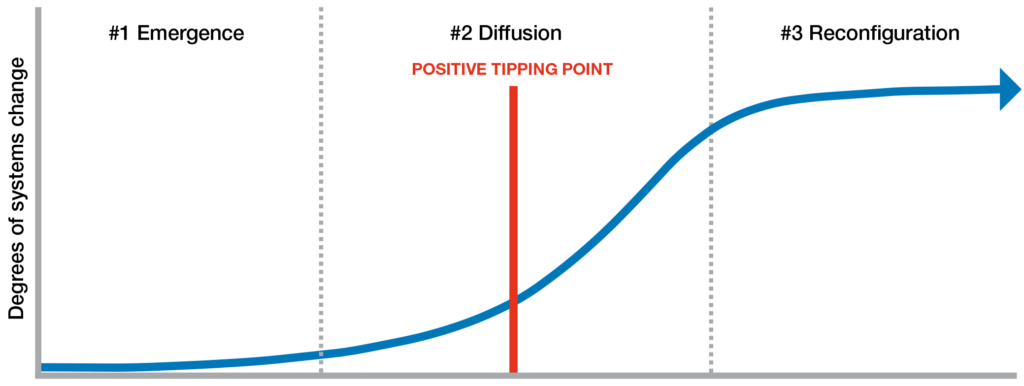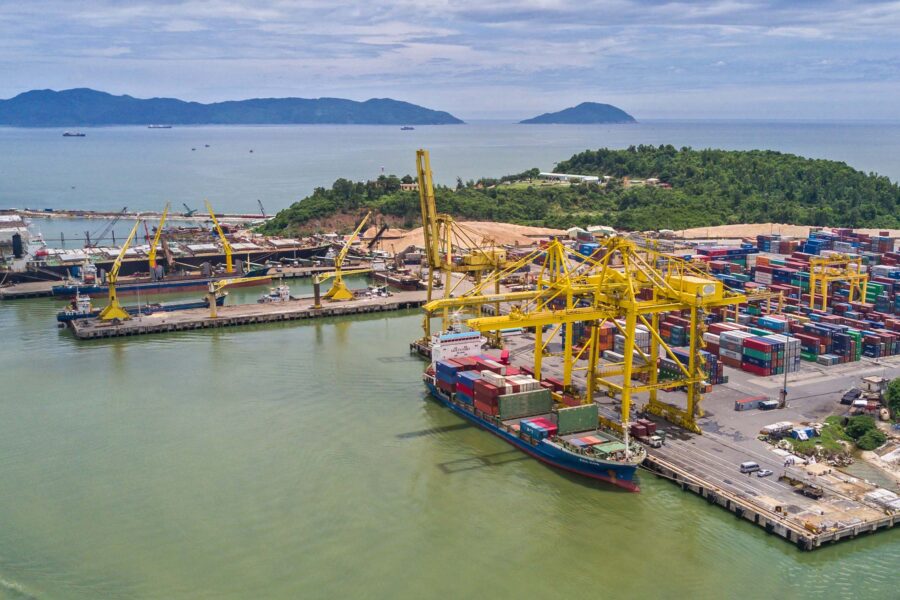Accelerating change for 1.5°C
Leaders across government, civil society, and the private sector must support the rapid, exponential growth of low and zero-emissions technologies if the world is to achieve the Paris goals
Climate

As the mounting headlines on heatwaves, wildfires, melting ice caps, and floods make clear, the speed and scale of global efforts to mitigate climate change have proven woefully inadequate in addressing the challenge at hand (see Table 1). Rapid, far-reaching transitions of unprecedented scale across power, transport, buildings, industry, land use, coastal zone management, and agriculture, as well as the immediate scale-up of technological carbon dioxide removal and climate finance, are now needed to limit global temperature rise to 1.5°C. And, as the latest science from the Intergovernmental Panel on Climate Change shows, our window of time to avoid the worst impacts of climate change is closing rapidly. This decade is our make-or-break opportunity to steer the world towards a net-zero greenhouse gas (GHG) emissions future.
The encouraging news is that we’re not starting from a standstill. Increasingly dynamic climate action is occurring within a handful of sectors, across some regions, and from individual companies, cities, states, investors, and civil society organizations. For example, several low-emissions technologies, including wind and solar power, have experienced rapid, non-linear growth over the past two decades, and sales of electric vehicles (EVs) have also increased dramatically since 2015. These bright spots show us what’s possible when decision-makers deploy the many resources and tools at their disposal to accelerate the transitions needed to halt global temperature rise.
Table 1: Assessment of progress towards 2030 targets aligned with limiting global warming to 1.5°C by sector

Such faster-than-expected progress can also occur when system-wide transitions are driven primarily by the advent and widespread adoption of new technologies, which historically have tended to follow an S-curve trajectory of growth (Figure 1). Initially, rates of adoption are quite low as entrepreneurs develop and pilot new innovations but then increase exponentially as these technologies reach a tipping point and begin to diffuse across society. After reaching a maximum speed, growth eventually slows down again as adoption approaches a saturation point.
After crossing a positive tipping point, positive, self-amplifying feedbacks can switch on and help accelerate adoption by driving down costs, enhancing performance of new low and zero-emissions technologies, and increasing social acceptance. Learning-by-doing in manufacturing, for example, can generate progressive advances that lead to more efficient production processes. Reaching economies of scale, meanwhile, enables companies to distribute the high costs of improvements across a wider customer base. Similarly, as complementary technologies (such as batteries) become increasingly available, they can boost functionality and accelerate uptake of new entrants (such as EVs). These gains allow once-radical innovations’ industries to expand their market share, deepen their political influence, and amass the resources needed to petition for more favorable policies. More supportive policies, in turn, can reshape the financial landscape in ways that incentivize investors to channel capital back into these new technologies. These reinforcing feedbacks accelerate adoption, help niche innovations to supplant incumbent technologies, and, in doing so, spur durable transformational change.
Supporting the S-curve
However, while the potential for rapid, non-linear change exists across many sectors, there is no guarantee that low and zero-emissions technologies will follow an S-curve. To catalyze, accelerate, and sustain the technology-driven transitions required to limit global warming to 1.5°C, decision-makers across both the public and private sectors must provide the right support at the right time, such as:
- Investments in research and development to help emerging low and zero-emissions technologies come to market. Channeling funding into designing, testing, and implementing demonstration projects of new technologies – for example, novel, low-carbon cements, steel produced using green hydrogen, and low-emissions fuels for road transport, aviation, and shipping – will be particularly important for decarbonizing the hard-to-abate heavy industry and transport sectors. Similar investments will also be needed to scale up technological carbon removal by developing new approaches and refining existing ones to optimize technologies and bring down costs.
- Financing for complementary technologies to support widespread adoption of low and zero-emissions innovations. Investments in complementary technologies, such as batteries for EVs or comprehensive charging networks, will prove critical in boosting adoption of low-carbon transportation technologies and in effectively integrating variable renewables, such as wind and solar, into electricity grids. Without these complementary technologies, new decarbonization innovations will likely struggle to reach positive tipping points.
- Leadership from key change agents. Establishing national climate targets, corporate commitments to reduce emissions, or announcements to phase out emissions-intensive technologies can help new technologies displace incumbents. In the power sector, for instance, ambitious coal phaseout targets from all countries are needed to send a strong signal to industry and avoid further carbon lock-in. Similarly, national commitments to retrofitting buildings can help guide a complex diverse community of actors towards decarbonizing the built environment.
- The right combination of incentives and disincentives. These market-based instruments, such as public procurement policies, reformation of fossil fuel subsidies, or pricing carbon, will prove critical to increasing adoption of new technologies across all sectors, as well as reducing use of emissions-intensive existing technologies.
- A stable regulatory environment that supports adoption for technologies beginning to diffuse. From renewable energy portfolio standards to building efficiency requirements that support uptake of heat pumps, command-and-control regulations can not only mandate adoption of low-emissions technologies, but also provide the stable regulatory environment the private sector needs to switch to decarbonization technologies.
Figure 1: S-curve

Other transformations will be critical
While these technology-driven transitions will prove critical to mitigating climate change, so too will transformations that may prove less likely to follow the S-curve dynamics, such as changing agricultural management practices or curtailing food loss and waste. Efforts to spur these changes will require a different set of measures that focus not on supporting technological development and adoption, but instead on:
- halting harmful practices like deforestation
- scaling up beneficial activities, such as reforestation or peatland rewetting
- triggering changes in behavior and social norms, such as those required to shift to more sustainable diets
- strengthening institutions to improve enforcement of existing laws and regulations
Conclusion
There is no guarantee of what exactly will spur rapid, non-linear growth of climate action across the globe, but it is clear that all hands on deck will be needed to stay below 1.5°C. The year ahead offers a tremendous opportunity to accelerate the systems transformations needed to avoid the worst climate impacts. These actions can be neither incremental nor delayed – we must seize this moment to secure a net-zero GHG emissions future for all.
This article draws heavily on the State of Climate Action 2021: Systems Transformations Required to Limit Global Warming to 1.5°C, produced under the World Resources Institute’s Systems Change Lab.





